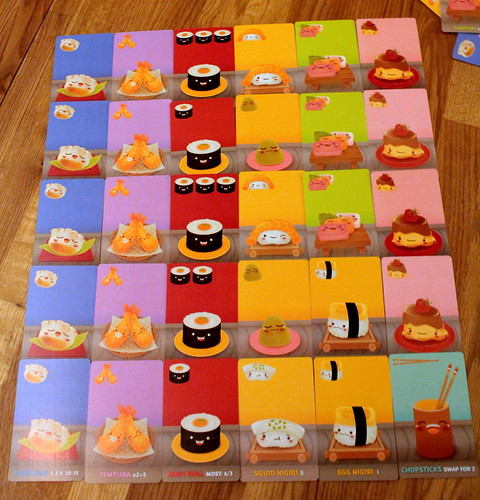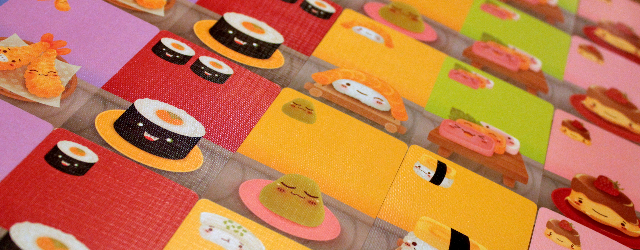| Strategy | Luck |
|---|---|
| Interaction | Components & Design |
| Complexity | Score |
Sushi Go! is a drafting game without any bells or whistles. Every player gets a hand of cards, pick one of them to play, pass the rest on to the next player, repeat until all cards have been played. Then count points, deal another hand and sum up points after three full rounds. If that sounds like 7 Wonders to you, that’s probably not a coincidence. But Sushi Go! has one big advantage over every other drafting game out there: the cards are sushi.

The cards in Sushi Go! all show different types of sushi – plus some related items – and each kind has different scoring rules. Maki Rolls, for instance, are all about quantity. The player with the most of them at the end of the round scores six points, the runner-up still gets three. Tempura Shrimps, always come in pairs, at least around here and apparently where designer Phil Walker-Harding lives as well: they score five points for each set of two, a single Tempura gets nothing. Sashimi works the same way, only you need three for ten points. See if anyone ever lets you collect that… . And with Dumplings I completely agree with the “the more, the better” approach: the more you have, the more points each of them is worth, from one point for one up to 15 for five or more. Finally, there are the three type of Nigiri that score points per piece, three for squid, two for salmon and 1 for tamago. I really miss the tuna here!
The nigiri don’t score as much as the other cards potentially can, but their points are not subject to any conditions, so that’s one plus for them. The other is that they are really, really good with Wasabi, one of the two special cards in Sushi Go!. Wasabi on its own is worth nothing – as you’ll probably confirm if you ever tried to eat it pure. But it’s simply divine on a nigiri. In game terms, the next Nigiri you play after Wasabi scores triple points. But it has to be that way around, you can’t play Wasabi on top of a Nigiri you already have.

The other special card is a pair of Chopsticks. They never score anything at all, but they are a very useful tool to eat sushi. If you have Chopsticks on the table, you can exchange them for a card from the hand you have at the moment. That’s on top of the card you play anyway, so Chopsticks let you take two cards from one hand. Since they go back into the hand in return, the total number of cards remains unchanged and some unlucky eater gets stuck with worthless chopsticks at the end of the round.
But wait! I forgot desert! All the cards mentioned above stay with you until the end of the round, then you count their points and discard them. But Pudding is different. You don’t eat Pudding between two servings of sushi. Generations of sushi masters would turn in their graves! You save Pudding until the end of the game, and the player who collected the most scores six points. And then the game is over and you have a winner and an appetite.
You will have realized from the description above, Sushi Go! does not try to compete with the likes of 7 Wonders. Sure, it’s also a drafting game, but of a much lighter kind. There are no resources to pay, there is no engine building, you pick any one card from each hand that’s passed to you and try to score the most points. Which one that might be involves a lot of guessing, especially in the first round. Cards are dealt from the full deck, so you don’t know for sure which cards are in the current round. I can’t even count the times I got two Sashimi only to find out there was no third. You have a slightly better chance on the third round if you’re good at counting cards. The missing Sashimi has to come out at some point, after all. But even then, luck plays a big role in Sushi Go!. And that’s okay, because this is a game you play while waiting for dinner. There are enough tactical decisions to keep you entertained that you won’t mind the low level of strategy. How much risk are you willing to take? Is it still worth competing for the Maki? Is scoring your own points worth more or less than keeping that last Sashimi from the next player?
Sushi Go! is quick, effortless, and above all fun. It’s a great way to pass the time until food arrives. Just don’t try to hold your cards with chopsticks. Trust me when I say it doesn’t work very well.







